By Kim McDarison
Supporting and affirming Whitewater’s growing Nicaraguan community was the focus of a community-based forum and panel-led discussion organized by the Whitewater Area League of Women Voters.
The forum, which was attended by some 40 members of the public, was held Thursday, April 20, at the Cravath Lakefront Community Center, Whitewater.
Attendees were invited to direct questions to four panelists, each of whom have been engaged with offering help, identifying needs and providing services to the growing Nicaraguan community in Whitewater.
Panel members included: Whitewater City Manager John Weidl, Whitewater Community Space Manager Kay Robers, and Whitewater Unified School District Multicultural Services Coordinator Terilyn Robles and Bilingual Liaison Jorge Islas-Martinez.
Also invited, but unable to attend, was University of Wisconsin-Whitewater International Employment and Immigration Specialist Margaret Wheeler.
The discussion was moderated by Whitewater Unified School District Board of Education member Miguel Aranda, who also is the pre-college programs associate director at UW-Whitewater.
The forum opened with each of the four panelists offering a presentation about their understanding and involvement with the Nicaraguan community, including services their individual agencies provide.
A self-help guide
Addressing forum attendees, Weidl said that there are “several ways” in which people moving into the community of Whitewater affects the delivery of city services, some of which he described as “normal” and others “acute.”
In response to questions associated with new arrivals within the city, Weidl offered a city-produced “self-held guide,” which, he said was created in both English and Spanish, to assist any of the community’s members, including the community’s most recent immigrants.
Weidl said the guide touched upon such topics as helpful websites; obtaining a driver’s license; getting work authorization as an asylum seeker, including sample applications; a flow chart for refugees, and other helpful pieces of advice.
The guide also offered some helpful legal information, as obtained through working with the Milwaukee-based firm of Christopher and De Leon. The firm specializes in immigration law, Weidl said.
He noted that for many asylum seekers living in Whitewater, the process starts with court proceeding held in Chicago or Milwaukee, which adds challenges.
To help provide answers, Weidl said, the city consulted with attorney Mark Christopher, whose contact information was made available in the self-help guide.
Like other community-based organizations, Weidl said, Whitewater officials and staff were interested in learning more about ways in which they could assist residents.
School district demographics, staffing
Robles shared demographic information from within the Whitewater Unified School District about multilingual learners and resources the district was providing to immigrant families.
Robles defined two terms, which, she said, are commonly used within school districts: “multilingual learners” and “newcomers.”
Defining multilingual learners, Robles said the term used an “assets-based approach” to identify students that had traditionally been called English language learners, English learners or emerging bilinguals.
“And,” she said, “that really just acknowledges that students are bringing with them a variety of languages and abilities, and they are not lacking something, because they have so much already, that we are simply adding to, so they are developing that multilingualism.”
Robles said that approximately 18% of the school district’s students are multilingual learners, which translates to approximately 400 students. The number included both immigrant and non-immigrant students, she said.
Some 96% of the district’s multilingual students speak Spanish as their first language. Other languages spoken by the remaining multilingual students include Mandarin, Russian, and Albanian, among others, she said.
Robles defined the term “newcomer” as a student who has arrived within the United States and has been receiving an education in a U.S. school for two or fewer years.
She noted that after two years of education, the student would no longer be considered a newcomer, but they may still continue as multilingual learners.
“That, too, can fade over time as they become fully bilingual students in our district,” Robles said.
To date, she said, about 8% of the district’s student population is composed of newcomer students, with about half of those students coming from Nicaragua.
“Some of the ways that we have responded to this influx that we’ve seen over the last two academic school years is through staffing, instructional and curricular supports, community outreach, and social services,” Robles said, noting that the district over the last two academic years, has increased its multilingual staff by six new members, including herself and Islas-Martinez. The other four additions came as members of certified teaching staff.
The multilingual services coordinator position, the role in which she serves, is new, she said, adding that this academic year is the first full year a person has filled that role.
In his role as bilingual liaison, Islas-Martinez, is charged with strengthening school-community connections for bilingual families, as well as providing access to resources and opening lines of communication, Robles said.
“Curricular supports are something that we continue to take a look at. So with our influx of population in the last two years, we also have to see if the curriculum that’s existing is actively fulfilling the needs of all of our learners, and so that’s just a continuous process that our district and all districts, go through as an evaluation of their curriculum, to see how we are meeting those needs or if there are things that we need to supplement to meet the needs of multilingual students, and other students in our populations as well,” she said.
Robles cited The Community Space, a community-based organization working under the umbrella of the Whitewater Community Foundation, to provide free items, such as food, clothing and furniture, to members of the community, as “an incredible asset for our families,” along with various social services though which students and families can find additional supports.
Said Robles: “We recognize that students, when they come to our school district, have a variety of experiences, both personally and then educationally. So we’ve really had to take a look at students who come to us who are considered SLIFE students; that acronym stands for Students with Limited or Interrupted Formal Education. So, it could be for a lot of things. COVID is one example that caused interruptions in a lot of students’ learning, so we actually have a lot of SLIFE students. But then experiences and immigration or political turmoil in countries that students come from leads to some gaps in education. And so we are actively working on how can we support students to fill those gaps.”
Robles said the district was seeing an increase in SLIFE students.
Additionally, Robles pointed to emotional and “potentially traumatic” experiences some students have experienced during their journey to the United States. She said the district was collaborating with organizations such as Open Arms and New Beginnings, and using onsite resources, such as school counselors, to help connect students and families with resources.
Community-based classes, housing
Islas-Martinez said he began working as the Whitewater Unified School District’s bilingual liaison last August.
He also said he was a founding member of a program that has been in place for 24 years called the “Whitewater Community Adult Liaison Program,” which, he said, today offers evening classes at the Whitewater High School and morning classes at the Whitewater Community Space where adults can learn to speak English.
The program is working to help families have more interaction in the community, he said.
“We provide childcare in this program, which make’s this program very, very unique,” he said, adding that the childcare component was important because: “at the time when the parents are learning how to speak English, they have peace of mind that their kids are in good hands.”
He noted that participants in the childcare program also are learning to speak English with aid from members of the Irvin L. Young Public Library, who read to the children and organize crafts. Funding for the childcare program comes through the United Way, he said.
Classes are offered through the program between September and July, he said, adding that most of the students come from Central American countries such as Guatemala, Salvador, Honduras, with the majority from Nicaragua.
The class is free, however there is a nominal charge for learning materials such as textbooks and workbooks, Islas-Martinez said, adding that the program works to provide materials for those who cannot afford them.
Another of his duties as liaison is to welcome and connect with new families arriving into the district, he said.
He provides information to help guide bilingual families as they place their children in school, explaining the most important things as parents they need to know about school, such as attendance, transportation, food service, and how they can communicate with the schools and teachers, he said
Among his tools is a folder of information provided in both English and Spanish, offering information on such topics as health and education, services offered to immigrants through Rock, Walworth and Jefferson counties, medical and legal supports, and social services available in the area. Also provided is a list of immigration attorneys and information to help immigrants understand their legal rights, Islas-Martinez said.
Housing, too, is among challenges with which he provides some assistance, he said. He described housing in Whitewater as “one of the most serious situations we have seen here.”
Islas-Martinez said he is able to assist by providing a list of apartment buildings where families might find housing. Families also have been aided by churches and through Bethel House in Whitewater, he said.
Said Islas-Martinez: “We try to provide the best that we can, and assist the families that are here who are new in the community … because Whitewater school district cares about the new families and cares about education and the well-being of all the students.”
‘No-one ever complains because there isn’t enough there’
Robers opened her comments with an overview of the Whitewater Community Space, which, she said, has been operating for five years.
“We have a very fine food pantry and we also have clothing, housewares, furniture, well, really, there isn’t anything that we don’t have. Everything that we have is free. We don’t require any information other than a zip code and the number of people in the household. We want everyone to feel welcome in that we don’t want anyone intimidated. We do pretty well, we’ve got, I would say that probably, at least 40% of our clients are Nicaraguan or other nationalities,” Robers said.
She said she and her volunteer staff use their phones to translate between English and Spanish, and the clients who come to the space do the same thing. Still, she said, over the last few years, she and the staff have memorized some “important sentences to say, and we communicate quite well.”
Robers said the clients that come to the community space are appreciative of the items made available.
“No-one ever complains because there isn’t enough there. They are always happy to get what they can,” she said, adding that when the Nicaraguan families first arrived, they needed mattresses, but they often left behind the box springs.
“They didn’t know what the box springs were, and we didn’t know how to tell them what they were, so we had all these box springs. We finally got that straightened out,” she said.
Finding transportation to deliver furniture items to clients offered a challenge, she said.
“It’s really a good feeling when we can help them. The kids come in and they like to look around,” she said, adding that when the community English classes are underway, the building is well used.
“They do scavenger hunts, because we have in our building, we have just anything there … we are just really happy to be part of the community and to be able to serve these people,” she said, adding: “Everything that we have comes in and goes out. No money crosses hands in our building.”
$1.9 million for housing
Addressing concerns about housing, Weidl said: “The biggest way the city is going to move forward and try to address some of the housing needs is it’s working on — we have $1.9 million to spend on making housing affordable essentially. And there’s one sentence of state law that governs how we go about doing that, so we have to develop a policy and a program based off of that.”
Weidl pointed to a public meeting that was then anticipated to take place Thursday, April 27, during which time a draft of the policy would be shared.
He described the developing policy has having three buckets.
Weidl said the first bucket provided some incentives to developers to create single-family homes.
“It’s not to build a 4,000-square-foot home, it’s to build 1,500- to 2,000-square-foot homes,” he said.
The second bucket proposed providing downpayment assistance for homebuyers, which, he said, would be income-based, using some qualifying criteria which was still under development.
A third bucket, which, he said, he thought would likely “get scraped” in favor of putting more money into the first two buckets, provided for a residential home rehabilitation program facilitated through the city’s CDA.
“While that’s a good idea, the feedback we tend to be getting from the community at this point is ‘let’s focus on homebuyers and building new units,’ and that’s fair,” he said.
Questions for the panel
The panel next fielded questions from audience members, which were submitted on note cards, and read out loud by the moderator.
Responding to questions, members of the panel said that donations to purchase textbooks and other learning materials used during the community English classes could be made through the school district.
Responding to questions regarding seeking legal help, Weidl suggested immigrants looking for advice should contact the Milwaukee firm of Christopher and De Leon.
Islas-Martinez also pointed to a Milwaukee-based civil rights group called “Voces De La Frontera,” further noting that attorney Mark Christopher works with the group.
The panel agreed that more immigrants from Nicaragua would likely make Whitewater their home.
Responding to a question asking for the difference between such terms as immigrant, refugee, asylum seeker and undocumented, Islas-Martinez said that the terms refugee and asylum seeker were “almost the same,” adding that an asylum seeker is a person who is fleeing a country in fear for his or her life. He said “the process of asylum” can take a long time, perhaps seven or eight years, and can cost in legal fees between $15,000 and $16,000.
The process is slowed by a small number of attorneys who will take asylum cases, he said.
Defining the terms “immigrant” and “undocumented,” Islas-Martinez said there are not undocumented immigrants in the U.S. Instead, he said, there are immigrants without legal status.
He said that all people are documented at birth, so everyone is documented, but if a person crossed the border without inspection, they become an immigrant without legal status.
Responding to a question asking why Nicaraguans were coming to Whitewater, Robles said that they were attracted to opportunities for housing, although, she said, she recognized there is a housing challenge, and opportunities in the area to work. Families also were attracted because some family members had already arrived in Whitewater and had become established, which encouraged other family members to come here and join them.
Islas-Martinez said services provided in the area also were a draw.
“For example, the Whitewater school district is offering more multilingual services. We have students that, if they move from Florida to here, and they are so surprised at all the assistance and help that they are getting at school in their native language,” he said.
Islas-Martinez also addressed questions surrounding asylum seekers and drivers licenses.
He said: “In the state of Wisconsin, it does not allow immigrants seeking asylum status to get a drivers license. So the process to apply for asylum is going to take seven or eight years, that means during those seven or eight years you will be driving because we don’t have public transpiration in this area. So we have to risk it to drive. I’m not promoting anything illegal, I don’t want to be taken the wrong way, but, we have to drive because we need to support our families.”
Islas-Martinez said efforts were underway, asking the state to allow immigrants without legal status to apply for a temporary drivers license, allowing them to drive. He cited safer roads and fees associated with applying for licensure as benefits associated with allowing a temporary licensing process.
With a license, he said, asylum seekers could buy a car and obtain insurance, which also would provide economic benefits.
He was hopeful, he said, that such an allowance might be made this year.
Robers was asked how the staff at the Whitewater Community Space was able to establish trust with the immigrant clientele.
“I don’t know how we did that, just from being nice, I think,” she said, adding that in one of the advanced English classes operating from the community space the students were writing essays. She learned that the students did not call the community space by its name, but instead called it “tienda de regalos,” meaning “the gift store, which I think is just awesome,” she said.
During the questioning period, panelists were asked: “What do you need most from the community members?”
Said Robers: “Mostly we need support. We need support as far as the food we give out, our utility bill is major, we pay more for utilities than we do for food. We need people to let people know that we are there, let them know the things that we give out.”
Said Islas-Martinez: “I think it is time that we need to start thinking about others, not only about ourselves. All of us, we are here in this great community, and let’s make this community unique and a great place to live.”
Panelists also were asked: “What do the immigrants need most from this community?”
Said Islas-Martinez: “Care,” and “equality.”
Said Weidl: “Grace,” and “access to transportation.”
Said Robles: “Support.”
Said Robers: “Acceptance,” and responding to the need for transportation, she said, “We’ve given away many bicycles.”
Addressing questions about pubic transportation, Weidl said that while the city would be interested in expanding its public transportation offerings, it was already struggling to provide the hours for which it has contracted with a third-party service called Brown Cab.
He saw working to solve that problem as “a first step,” he said.
A question was asked: What can we say to those who say that immigrant students are a drain to the community?
Robles responded by saying that immigrant student are “an asset.” She cited advantages they bring into the classroom space both linguistically and culturally.
Further, she said, “There are some grants that we have access to through the increase in immigrant students. So there’s the Immigrant Children and Youth grant we were able to get this past year and are eligible for the next year as well.”
She said the district was awarded 40,000 from the grant this past year, and she will apply for the same grant next year.
Weidl, too, responded to the question, saying that organizations are struggling to find people who are bilingual.
“And the school district is churning them out. I look forward to the day that one of these children graduates, and goes to college here, and applies for a job in one of our organizations, and we hire them. It’s not a drain at all. This is our future workforce that is going to be positioned and have the skills to deal with some of these challenges in a way that I cannot,” he said.
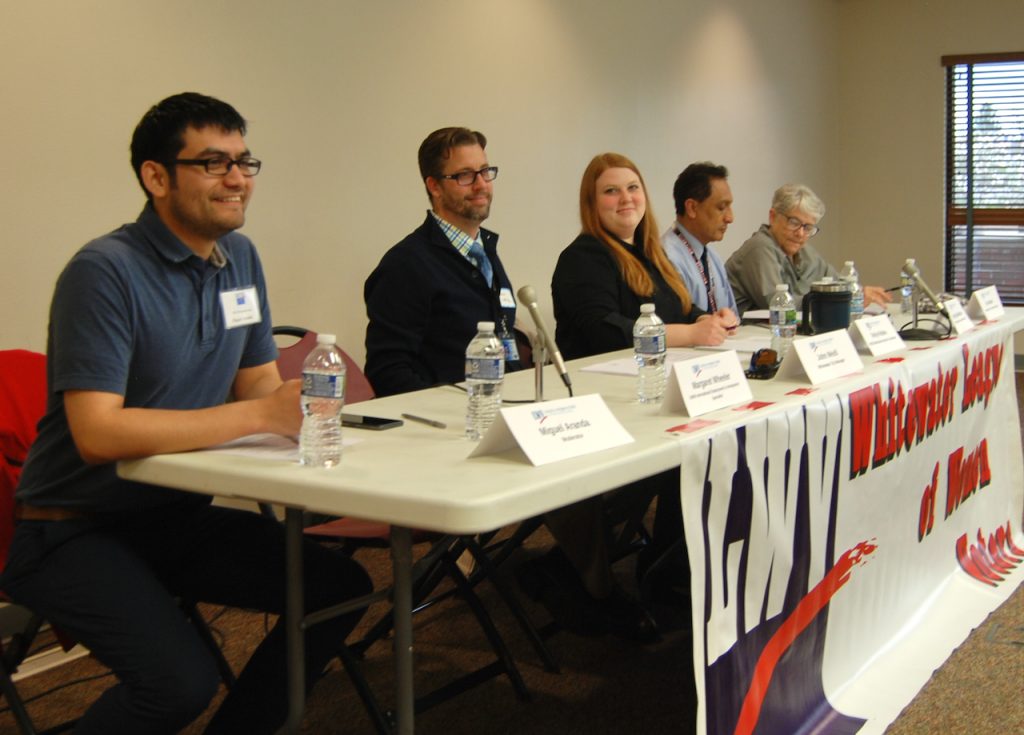
Moderator Miguel Aranda, from left, along with panel members Whitewater City Manager John Weidl, Whitewater Unified School District Multicultural Services Coordinator Terilyn Robles, Whitewater Unified School District Bilingual Liaison Jorge Islas-Martinez and Whitewater Community Space Manager Kay Robers, offer comments and field questions from some 40 community members regarding how best to support and affirm Whitewater’s growing Nicaraguan community.
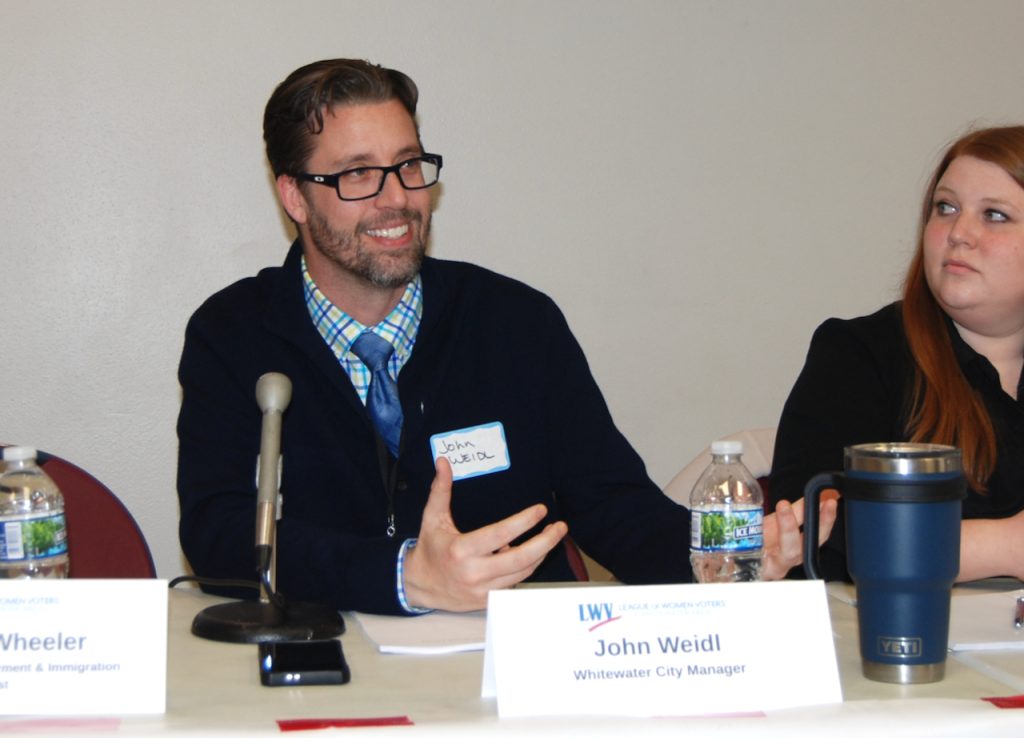
Whitewater City Manager John Weidl talks about a self-help guide produced by city staff to provide immigrant members of the community with information and answer questions.
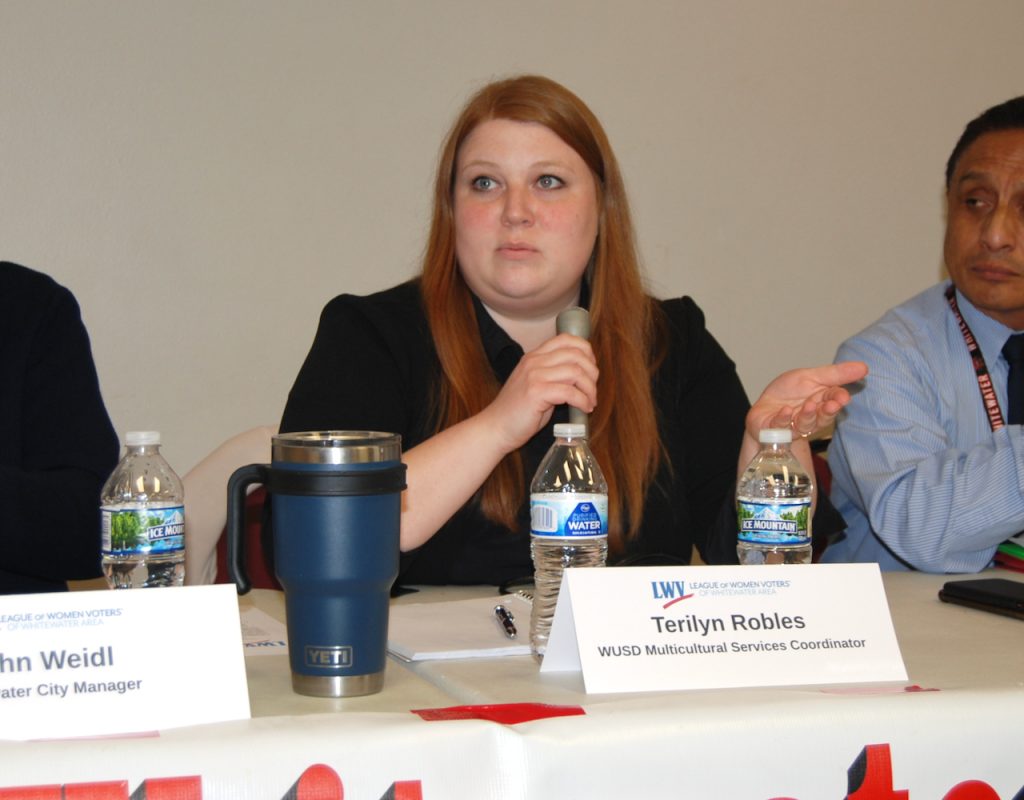
Whitewater Unified School District Multicultural Services Coordinator Terilyn Robles offers statistics regarding school populations as they relate to multilingual learners and newcomer students.
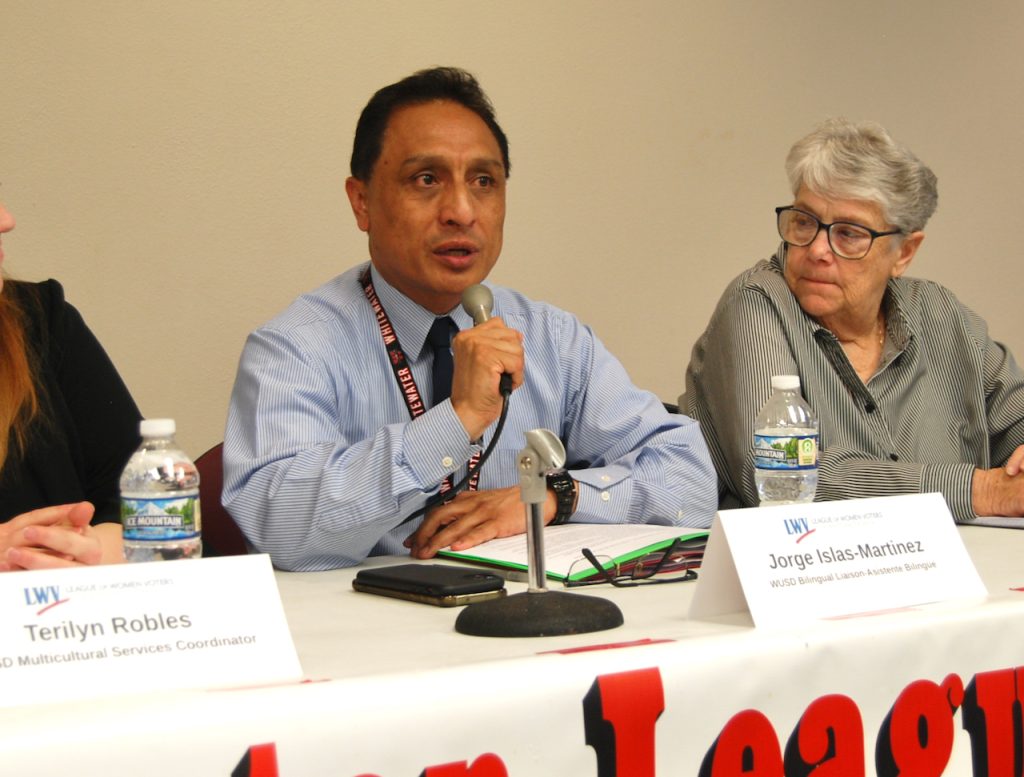
Whitewater Unified School District Bilingual Liaison Jorge Islas-Martinez offers information about a community-based English language class offered to adults.
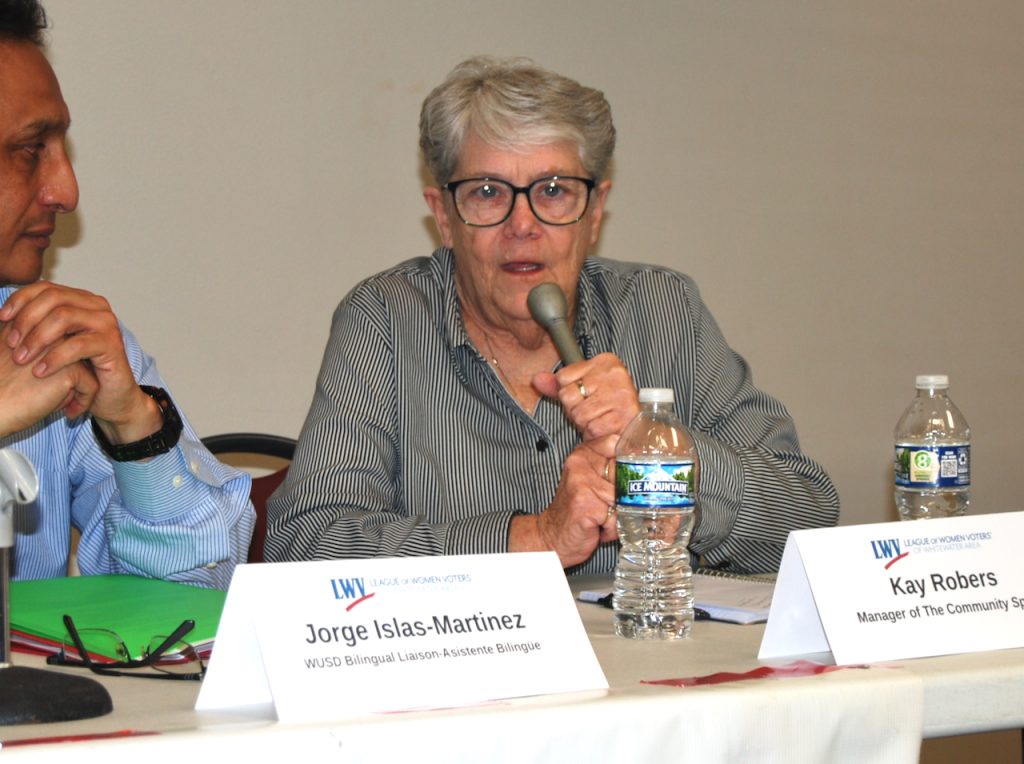
Whitewater Community Space Manager Kay Robers talks about the organization, which offers free items to any member of the community. She said Spanish-speaking immigrant clients call the space “The Gift Store.”
Kim McDarison photos.
This post has already been read 4525 times!
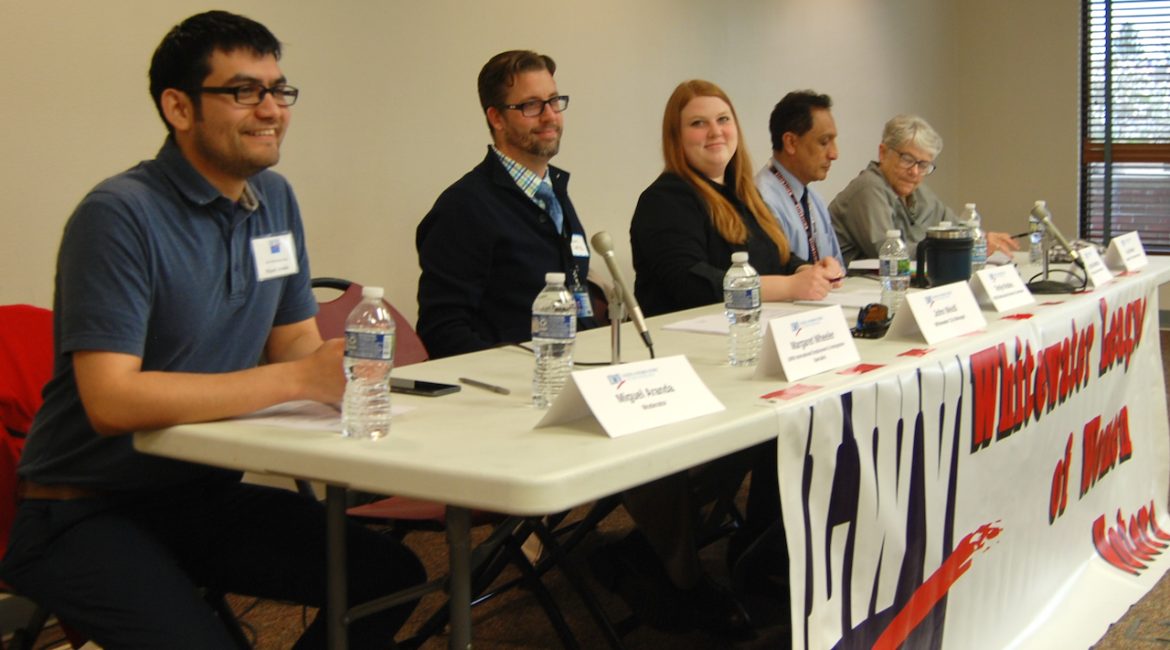
The Whitewater School District is in the bottom third of the state academically, in no small part because of a huge influx of children who’ve come here illegally, speak no English, and have never been in a classroom. The district has hired a clearly clueless Ms. Robles, mentioned in the article, who referred to such children as “assets.” I have several friends who teach at Whitewater who laughed at that blatant lie. It is illustrative that Ms. Robles teaches zero classes at Whitewater, and the district had zero actual classroom teachers at the forum to explain reality; these children require extensive resources that would otherwise be used for non-immigrant children, and that as the district has received a huge influx of these “assets,” academic achievement for everyone has dropped precipitously.
I heard Ms Robles is being considered for curriculum director. Let’s hope the new school board sees Ms. Robles for the detached-from-reality mouthpiece she is and instead shows her the door.